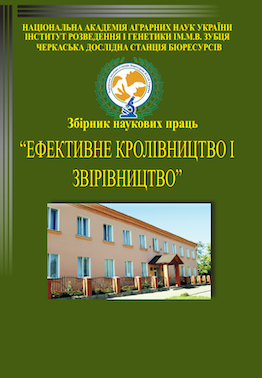THE PERFORMANCE QUALITIES OF LITTLE MALES, RELATING TO PARATYPIC FACTORS
DOI:
https://doi.org/10.37617/2708-0617.2020.6.88-99Abstract
The article presents materials for studying the seasonal variability of semen productivity of male rabbits of the breed Poltava silver under conditions of keeping in the capital production room of the Cherkassy Biological Resources Research Station of the NAAS. The most significant was the effect of seasonal variations in air temperature in the summer. During this period, the corresponding figure in the room averaged 25.5 ° C and outside - 22.9 ° C. The males, like the rest of the livestock population, seemed somewhat
depressed. The overall need for water for irrigation was increasing and the amount of feed consumed was decreasing. On the basis of the conducted researches of indicators of
spermproductivity ofrabbits the season of variability was established.
Thus, in particular, when measuring the volume of sperm ejaculate in the first
ejaculate, a significant difference was found before its increase in winter and a slight decrease in the rest of the seasons. The gradual decrease of this average from winter to summer is more pronounced in the second ejaculate. The largest significant difference for this indicator is found when comparing winter to summer. The volume of the second sperm ejaculate was greater than the first in all seasons. In determining the sperm concentration in both ejaculates, it was highest in winter and lowest in summer. There was a trend of gradual seasonal decline of this indicator from winter to summer. Second semen concentration ejaculates were generally better than the first in all seasons of the year.
When evaluating sperm motility in both ejaculates, the highest was observed in winter and the lowest in summer. The tendency to a gradual seasonal decrease of this indicator from winter to summer is revealed. In all seasons of the year in the second ejaculate sperm motility was significantly higher than in the first.
In determining the total number of active sperm in the ejaculate also revealed seasonal variability in both ejaculates - a gradual decrease from winter to summer. For two ejaculates, the highest was in winter and the lowest in summer. Also in the second ejaculate, regardless of the season, the total number of active sperm was significantly higher than in the first. Similar seasonal changes were observed in the calculation of the number of conditional sperm doses, which can theoretically be obtained from one ejaculate sperm of a male, proportional to its total number of active sperm.
Thus, the conducted studies of the sperm productivity of male rabbits testified to its seasonal variability, as well as advantages as the second ejaculate over the first. The analysis of variance also confirmed the probable influence on the variability of the vast majority of investigated indicators of sperm productivity.
The results of the research can be taken into account when planning the reproduction of the herd on farms depending on the season of the year.


